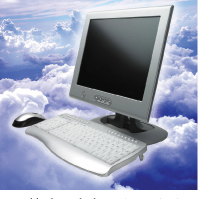By: Brenda J. Trainor

We’re hearing it in tv ads: “to the cloud!” The latest buzz word in information technology is cloud computing, but what does that term really mean?
Cloud computing is actually a simple concept of decentralized computer power. The cloud is a term that substitutes for Internet access – computer applications are accessed through the Internet via your computer’s browser. You don’t have to go out and buy the physical copy of a package of software and install it in your computer – you simply connect via the Internet to access a set of applications.
Of course, the requirement for Internet is essential to making cloud computing functional, and the faster the better. As with any trend, there are advantages and disadvantages to implementation. 
Advantages:
Computers are becoming smaller and more portable. With a wireless Internet connection, cloud computing brings the power of entire networks to your laptop no matter where you may be physically located. That means your entire suite of data can be somewhere else, but you can still access it and get your work done without needing to be tethered to the mainframe.
Computers are also getting smaller – iPads and new popular tablet computers as well as smart phones are becoming powerful computer tools, and cloud computing allows these small and simple devices to perform a wide range of functions as powerful as old desk top machines. This means you don’t necessarily need a desk-based machine with a disk drive, electricity, and an Ethernet port to your network. The untethered tablet computer with a battery and wifi connection can make the connection and get the work done.
If all your workers are this flexible, imagine how easy it is to launch a new application protocol -- an email can be sent out with new access instructions, and your whole enterprise can connect to a new software service almost instantly by following the instructions. Compare that to the old way of launching a new application when you would have to install software on each desktop with your specialized systems support person or the vendor after having purchased the coded software package for each unit. Remember how long it would take to deploy an innovation in the old days? Things can happen faster in the cloud.
Cloud computing also has an advantage of sharing data. Because it is stored out there in the cloud, many users can get access to the same field of data – it can be updated and simply maintained in one place, yet it is useful to those users to whom access you have granted. It can also be stored with back up and redundancy to a secure location.
Disadvantages
So as easy, affordable and accessible as cloud computing applications can be, there are also some disadvantages. Chief among these is security. It can be challenging to assure that all that remote access is not opening a path to an intruder into your system. There are ways to build in security through log-in procedures and passwords, but it is important to work with your provider to assure that only the right people are using your data.
Cloud computing is also only as good as the Internet connection on which it travels. Remember, these applications are remotely served, so they are dependent upon the connection you provide – if that link is severed, production is halted until it is restored. Attention must be paid to getting a good connection.
While cloud computing can be efficient, attention should be paid to costs as well – licensing fees and user fees should be monitored so that you are paying for the services you need, not the services you don’t use anymore but are still paying for. If the advantage of a cloud application is like a utility, you buy what you need when you need it; but if you forget to terminate a service, you end up paying for connections that you aren’t using and can waste resources.
Conclusion:
Going to the cloud can bring you applications and computer resources in an efficient manner that can be affordable and quick to implement. But the cloud can be murky as well – you must launch applications into your business operation with an eye to efficiency and good system design so as not to waste resources and to best use the innovations that data sharing and security can provide.
Brenda J. Trainor
Frontier Trail, Inc.
Box 935
Monrovia, CA 91017
323.229.2397
Trainor@FrontierTrail.com
www.FrontierTrail.com

|